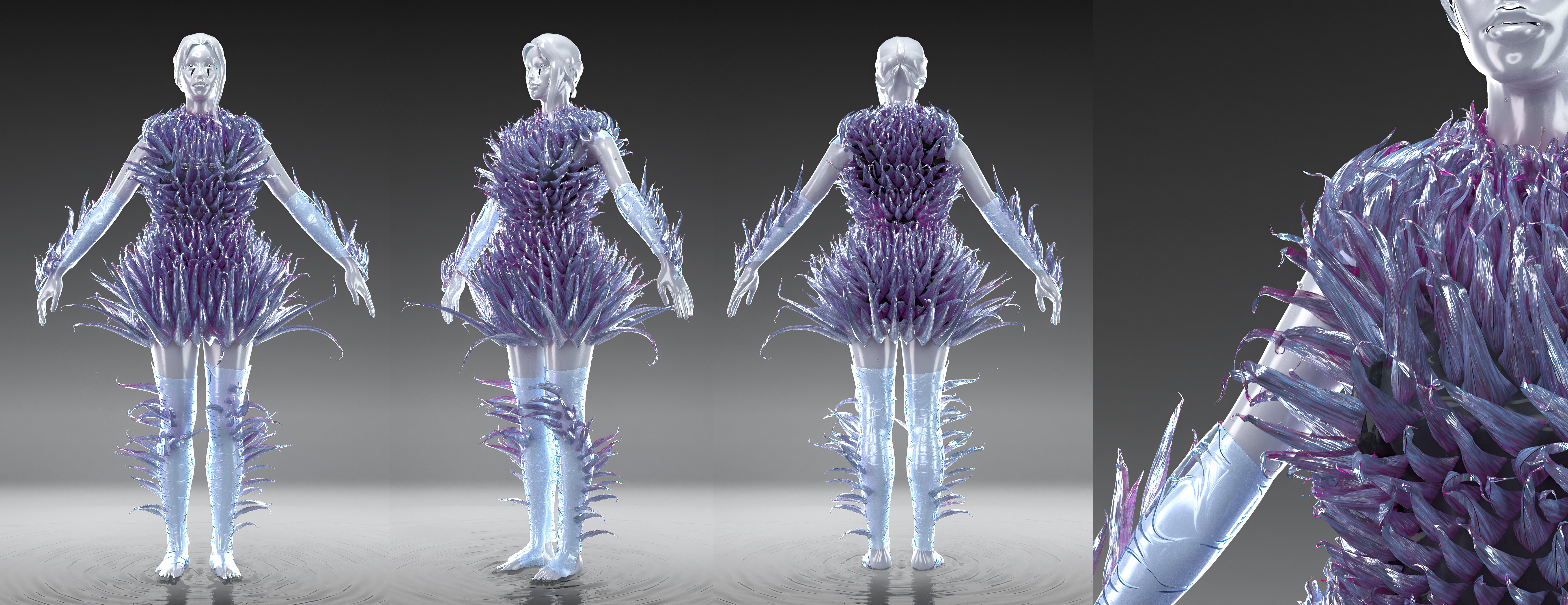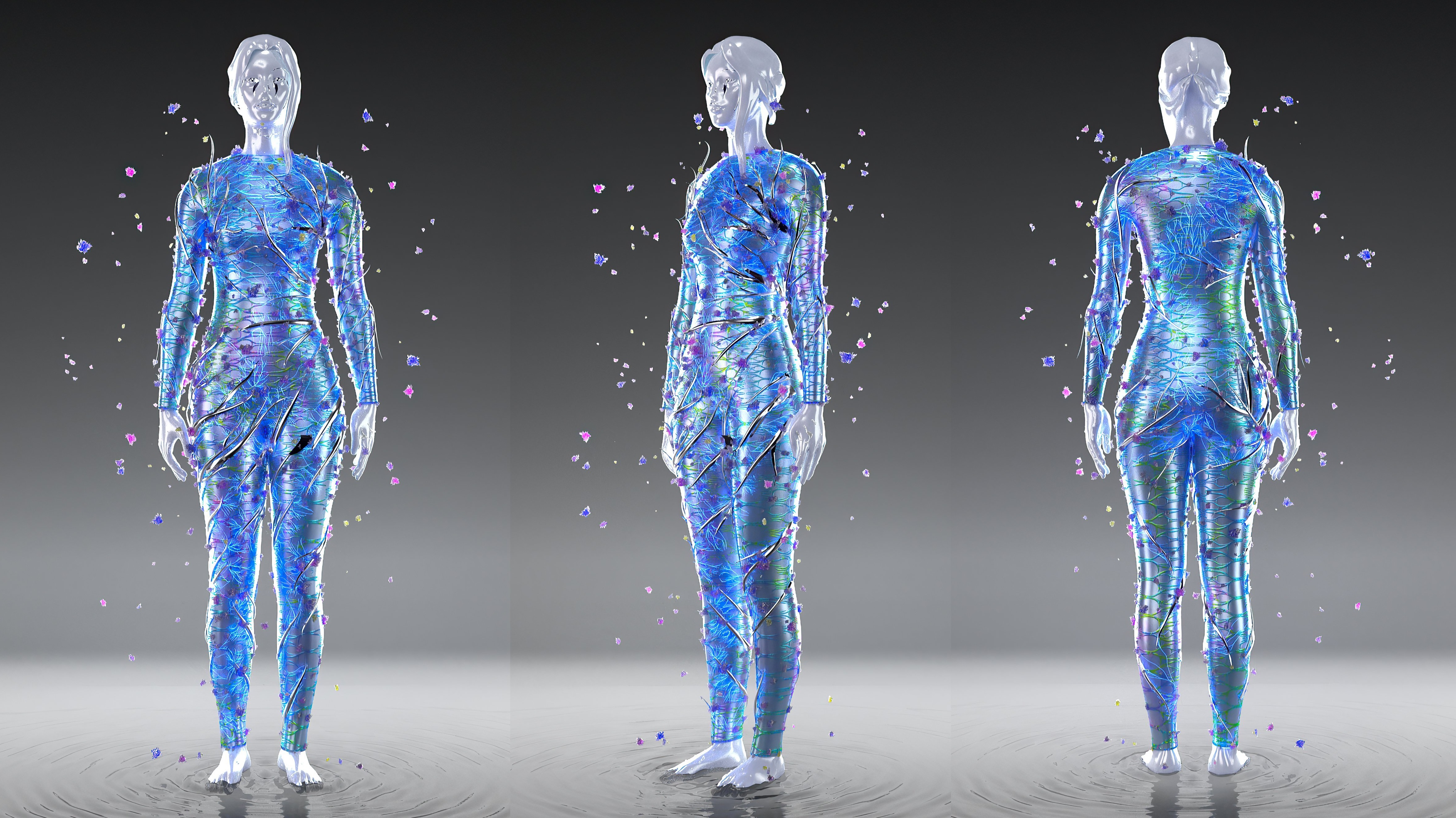
I am in my suburban garden wearing an electric blue bodysuit which makes me look part water-sprite, part cyborg. Tendrils coil around my limbs. Impossible violet petals unfurl at my feet and explode around my body. What will the neighbours think?
Actually, if the neighbours looked they would see me shuffling around awkwardly in front of my husband’s iPhone lens, wearing a black vest and leggings, trying to find an angle that hides the sandpit. It is only later that the catsuit - designed by London duo Auroboros - is superimposed on to the image.
This is digital fashion and - sci-fi as it looks - a raft of companies are betting on its prominence in fashion’s near future.
At the moment, these mind-bending virtual creations are either superimposed on still images, posted to social media, or created for avatars to wear within multiplayer games - but they aren’t free. The one I am wearing has a decidedly designer price tag of £780 ($NZ1500).
In 2019, a shimmering ‘‘Iridescence’’ dress by The Fabricant sold for £7800. At the more accessible end, another company, Tribute Brand, sells digital garments, worn on Instagram by the likes of uber-fashion influencer Veronika Heilbrunner, for about the £36 ($NZ70) mark.
In the gaming world - now worth more than sports and movies worldwide - digital fashion is already booming. The market for ‘‘skins’’, which enable characters to change their in-game appearances, is predicted to reach £36 billion by the end of 2022, while Fortnite, which has more than 250 million global users, reportedly earns nearly £220 million a month in skins already.

Increasingly, mainstream fashion brands are getting in on the action: last month Gucci produced a pair of virtual neon-green sneakers, for £9, to be ‘‘worn’’ in augmented-reality (AR) gaming worlds, as well as on social media. And just as NFT (non-fungible token) artworks have been selling for jaw-dropping prices - notably last month’s sale of a work by Beeple for more than £50million at Christie’s - so, too, have NFT sneakers.
Earlier this month, a collaboration between ‘‘crypto native’’ brand RTFKT (pronounced artefact) and 18-year-old digital artist Fewocious, made the equivalent of £2.24 million in seven minutes with the sale of 621 pairs of NFT trainers - collectable digital files which come in limited editions, and are marked for authenticity. Physical trainers will eventually be sent to owners of the NFT files, but the company’s co-founder, Benoit Pagotto, describes these chattels as a mere ‘‘bonus’’.
In the past fortnight, RTFKT made a further £200,000 selling six virtual-only sneaker designs, in collaboration with Atari.
‘‘Things are crazy these days - I’m having fun,’’ says Pagotto, whose friends keep phoning him to ask him if he’s rich yet (‘‘it’s not in my bank account - we’re a company’’, he assures me.).
‘‘People have been applying filters to their Snapchat and Instagram for years, so the appeal of being able to control your image online is very much part of mainstream culture,’’ says Francesca Muston, vice-president fashion, at trend forecaster WGSN.
Auroboros’ designers, Paula Sello (24) and Alissa Aulbekova (22) explain that the garment I am ‘‘wearing’’ was inspired by the Alex Garland film Annihilation and ‘‘deep sea plants and flowers’’.
The pair are in talks with a raft of tech companies and believe that in about six months’ time it will be possible to ‘‘wear’’ digital fashion using the same kind of AR as has become commonplace in facial filters, but which tracks the whole body in 3-D, using Lidar cameras, which are already installed on the latest iPhones and iPads.
The step beyond that, they ardently believe, is experiencing AR digital fashion ‘‘off the screen’’. For example, using AR glasses, currently being developed in earnest by the big tech companies, you could look at a friend in real life and see them ‘‘wearing an Auroboros gown made of water’’.
Creatively, says Sello, it is ‘‘an entirely new form of expression’’.
‘‘So far the 21st century has pretty much been a repetition of everything done in 20th century. But now we have the capacity to wear fire or water on an everyday basis.’’
There are plenty of sceptics who either dismiss digital fashion as an internet-era emperor’s new clothes or worry it signals that humanity will slump in front of screens as our minds are further sucked into the Matrix.
‘‘Technology doesn’t have to be terrifying - it can be utopian as well,’’ says Sello. She points out that digital fashion can be experienced communally and offers a potential sustainability win.
Prof Carolyn Mair, a behavioural psychologist specialising in fashion, believes it could scratch the same itch as fast fashion. Humans are wired to seek out novelty, she says, and ‘‘pleasing aesthetics, which is why the essence of fashion is that it keeps reinventing itself’’.
Digital outfits could satisfy this need, giving the same ‘‘self-esteem boost’’ as the much-maligned trend for people to wear new outfits each time they post on social media, but without making physical garments to be sent to landfill. It is also true escapism, says Mair, ‘‘which much appeals at the moment’’.
Pagotto says something strange has happened.
‘‘Now, occasionally, when I browse Instagram and see normal pictures and normal shoes, it feels very boring, like I am looking at the past.’’
- Guardian News and Media












